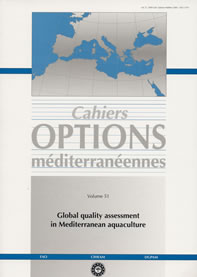| Article précédent | p. 71-77 | Article suivant |
Optimisation of slaughtering method in gilthead sea bream (Sparus aurata). Industrial application in fish farms
It is well established that the slaughtering method affects the quality of cultured fish. Therefore the handling and post-harvesting procedures should be modified to develop products of the highest quality. Actually there are different methods: asphyxiation, percussive stunning, CO2 narcotization, electrocution and ice with water, but in some cases their application is limited. In this paper 'liquid ice' is proposed, compared with 'conventional ice', as an effective method to improve freshness for long time. Body and ice temperature, flesh texture (puncture and compression), freshness (K-value and degradation products of ATP) and external colour (Lstar, Cstarab and H°ab) was evaluated in 216 fish slaughtered in the ADSA fish farm (Canary Island, Spain). The analysis of texture was performed using an INSTRON 4465 Texturometer. High performance liquid chromatography (HPLC) was applied for identification and quantitative determination of nucleotides and K-value.
- [ Afficher ]
- [ Télécharger ]
- [ Exporter la citation ]
Vous pouvez télécharger la citation au format :
- [ Imprimer ]
-
Mots-clés
ABATTAGE D'ANIMAUX, AQUACULTURE, COULEUR, PRAGUS AURATA, QUALITE, TEXTURECiter cet article
Urbieta F.J., Ginés R. Optimisation of slaughtering method in gilthead sea bream (Sparus aurata). Industrial application in fish farms. Global quality assessment in Mediterranean aquaculture. Zaragoza : CIHEAM, 2000. p. 71-77. (Cahiers Options Méditerranéennes; n. 51). Workshop of the CIHEAM Networks on Technology of Aquaculture in the Mediterranean (TECAM) and Socio-Economic and Legal aspects of Aquaculture in the Mediterranean, 1999/11/29-1999/12/01, Barcelona (Spain). http://om.ciheam.org/om/pdf/c51/00600293.pdf



